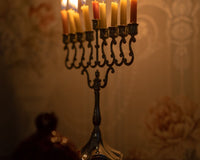Armenian ceramics pottery in Catholic history is distinctive because it is decorated uniquely with painting. As early as 2,000 BC, Armenia was already making burnished redware of superior quality. Excavations from that era reveal pots and bowls of numerous sizes and shapes.
The diverse range and the quality of Armenian ceramics in the Urartian period are particularly noteworthy. Potters skillfully replicated metallic vessels, such as Erebuni’s drinking cup or the well-known shoe-shaped rhyton.
Armenian Ceramics from 5th to 13th Centuries
Following the end of the Urartian period in the 6th century BC, it appears that the development of Armenian ceramics pottery slowed down till the Middle Ages. Archaeologists have not been able to find any impressive pottery items from that period that were locally made.
However, the archaeological findings at Ani and Dvin – the capital cities of Armenia during the 5th to the 11th centuries – reveal some stunning examples of pottery. A number of these items show that the potters of that time followed the fashionable trends prevailing in the region. The excavations also indicate that from the 11th to the 13th century, the Armenian ceramics industry, particularly at Ani, was flourishing with outstanding quality productions.
Armenian Ceramics at Kutahya
Kutahya, a major city located near Constantinople in Asia Minor, became one of the key centers of Armenian ceramics in the post-medieval era. The handicraft industry in Kutahya was dominated by Armenian-made ceramics. By the turn of the 15th century, a large number of Armenians were heavily engaged in the ceramics industry.
The skilled potters in Kutahya were also known to manufacture square tiles that were primarily used for wall décor. One of the most breathtaking examples of Kutahya pottery tiles is found in Jerusalem’s Armenian St. James Cathedral. One of the highlights of this edifice is a unique set of pictorial tiles that depict scenes from the Old and New Testament in polychrome along with an Armenian inscriptional band.
Popular Ceramic Forms at Kutahya
The ceramics industry at Kutahya earned huge popularity for an interest form – ornaments in egg shape. These ornaments were hung on the chains that were used to suspend oil lamps in churches. These egg-shaped Kutahya products were decorated in a variety of ways. One of the popular displays was seraphim (legendary 6-winged angels).
Some other sought-after shapes of these Armenian ceramics included monogrammed plates, cups, saucers, lemon squeezers, and flasks for rose water. Whether it was the eggs, incense burners, flasks, or water jugs, the vessels made in Kutahya were popularly marked by Armenian inscriptions.
Kutahya’s ceramics industry continued to thrive until the ravages of the First World War forced the Armenian potters to flee the region to escape from being persecuted. Many of the families of the craftspersons finally managed to settle down in Jerusalem. Here they have kept their original craft alive by making Kutahya type polychrome Armenian ceramics as the keepsakes and memorabilia of the Holy Land.
Choose Our Exclusive Items from the Holy Land
At Holy Land Market, we are proud to offer an eclectic range of cultural and religious products from the Holy Land. From ceramics to jewelry to stones to icons to kitchenware, our collections are crafted with the dedication and care of skilled craftspersons from the cities of the Holy Land. Place your order by calling us at 1-612-454-7916 or reach us online.






